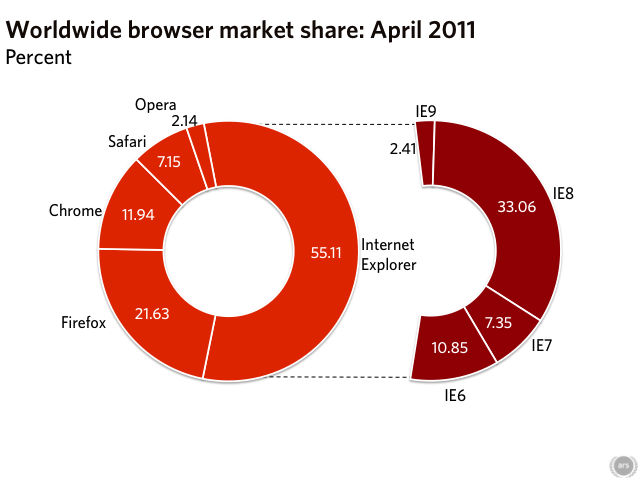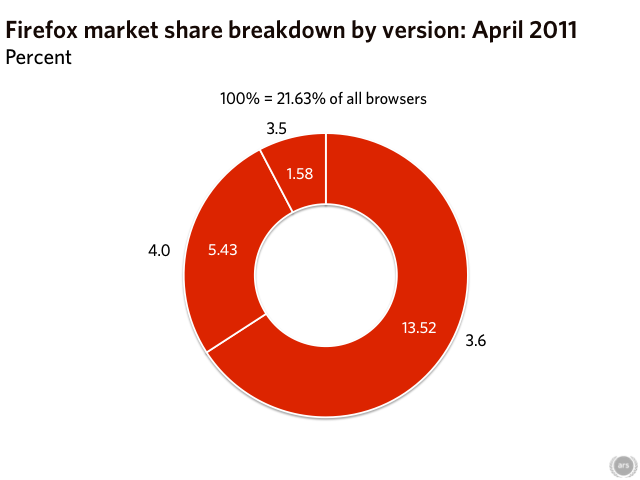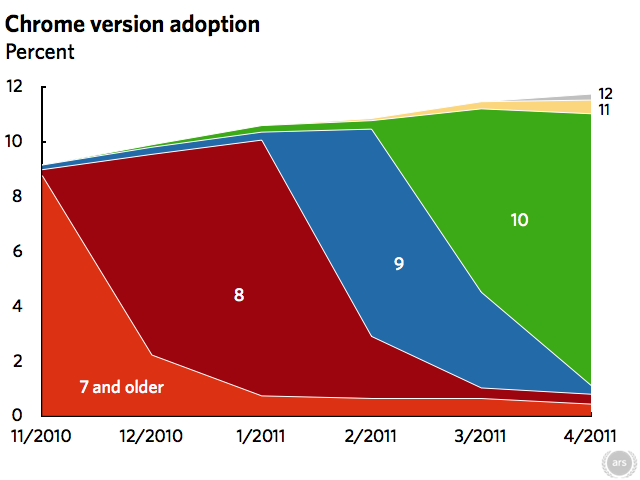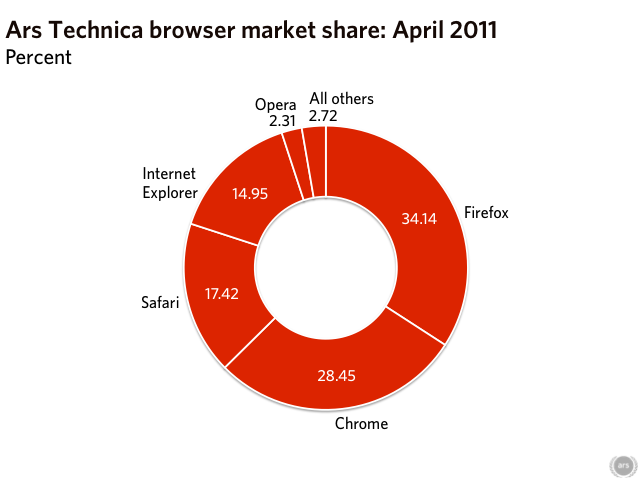April was the first time that Internet Explorer 9 and Firefox 4 were available for the full month, making it the first chance to really get a feel for how rapidly users are switching to the new offerings—and the first opportunity to see if compelling new versions are able to halt Internet Explorer's market share slide, or spur new interest in Firefox.
Both Microsoft and Mozilla will be disappointed to learn that so far, nothing much has changed. Internet Explorer is down yet again, dropping 0.81 points to 55.11 percent. Firefox experienced a small drop of 0.17 points, to 21.63 percent. Chrome was up 0.37 points to 11.94 percent, and Safari was up 0.54 points to 7.15 percent. The implication from this is that the new browsers, though both substantial upgrades over their predecessors, are doing little to attract users of other browsers; the people switching to them are merely upgraders.

Taking a look at a version breakdown and this pattern is plain to see. Internet Explorer 9 is up 1.37 points over last month's share, with Internet Explorer 8 dropping by almost the same amount, 1.35 percent. Versions 6 and 7 both saw slight declines, just as they've been doing for many months now. The situation for Firefox is similar. Firefox 4 is up 3.75 points, to 5.43 percent; Firefox 3.6 is down 3.66 points, to 13.52 percent. Usage of older versions (3.5 and below) declined slightly, again as has been the case for many months.

On the basis of what we've seen so far, then, the browsers are appealing only to their existing fanbases—and even that appeal is somewhat limited, as both browsers are suffering continued defections to Chrome and Safari.

Upgrade failures
Both browsers show another trait not found in Chrome—a hardcore minority of users sticking with ancient versions of the software, and a slow process of upgrading. Internet Explorer is the best-known victim of this, with fully one-third of Internet Explorer users sticking with version 6 or 7, and only 4.5 percent of Internet Explorer users using the latest and greatest version. Firefox's situation is not as pronounced—12 percent of users are on 3.5 or below—but still shows some of this same "stickiness"; only 25 percent of Firefox users are on version 4.

Compare this with Chrome. While Chrome does have a similar number of people using very old versions—9.5 percent on versions 9 or below—the people who do upgrade do so far more rapidly. Version 10 was released in early March, at around the same time as Internet Explorer 9, and yet by April more than 90 percent of Chrome users had switched to that version or newer.

The reason for the rapid cut-overs is, of course, that Chrome automatically, and silently, updates to the latest appropriate version, when neither of the other browsers do. Microsoft relies on Windows Update to offer upgrades, and Internet Explorer 9 won't be rolled out to Internet Explorer 7 or 8 users until June (though users of the beta and release candidate have already been offered the upgrade). Even when the company throws the switch, the upgrade will be optional, and if prior Windows Update rollouts are anything to go by, will explicitly prompt users to upgrade rather than silently installing like a normal hotfix. It's likely that some of them will refuse the update.

Firefox 4 includes automatic updating; the browser will download updates when they become available and attempt to install them. However, this automatic installer will only install minor updates (for example, it should automatically install the new 4.0.1 security update); major updates will still prompt users. More problematically, Firefox can generally only be updated with administrative privileges (Chrome, in contrast, preferentially installs itself to the user's own directory, meaning it has no such requirement), so even its automatic updates will result in UAC prompts. A move to silent updates is currently under consideration for future versions of Firefox, and with Mozilla hoping to move to a more regular update model, this is something that will surely be necessary if massive fragmentation is to be avoided.
Microsoft argues that users should have control over their browser as a matter of principle, and that corporations specifically require control over the upgrade process. The company makes it easy to opt out even from security updates, let alone feature upgrades. From a certain standpoint, this is obviously a fair point—it's the user's computer (or the corporation's computer), not Microsoft's, so the user should ultimately be in control.
But putting users in control has external costs. Worm epidemics, botnet trojans, and other malware incur costs for more than just the infected; spam, for example, costs virtually every user of e-mail both time and money. Almost all large-scale virus and worm infections are a result of users refusing to install patches as they are made available. People who walk around with untreated tuberculosis can be forcibly restrained until they are cured, because of the threat to public health that they cause, and many argue that people who use unpatched computers should be similarly penalized—a motive that would strongly encourage automatic patching, at the very least.
Automatic feature upgrades are a little harder to justify—people are allowed to be anachronistic, just not health hazards—but refusal to upgrade to modern browsers does result in similar costs to owners and operators of Web sites. Web developers around the world would rejoice if Microsoft would aggressively roll out upgrades to force Internet Explorer users onto version 9 where possible and version 8 otherwise, and such a move would allow a much wider range of much richer Web applications. It would also be far more effective than the company's current marketing campaigns to encourage people to upgrade.
The success of Google's Chrome—the only browser to show any consistent growth these days—also suggests that users are less bothered about "control" than perhaps Microsoft believes. As long as the updates are automatic, reliable, and most importantly, unobtrusive, automatic updating is proving popular. A happy medium might be to make automatic updating the default, but allow corporations to defer updating for a limited amount of time to accommodate testing. In this way, home users would be kept current, even if compatibility constraints prevented businesses from living on the cutting edge.
Ultimately, a failure to push out updates undermines the development work invested in the browser. Firefox 4 and Internet Explorer 9 are both excellent browsers, but this excellence counts for nothing if users are sticking with old versions. This hurts Microsoft particularly; not only is the leap from 8 to 9 greater than Firefox's leap from 3.6 to 4, but perceptions of the browser are also strongly influenced by Internet Explorer 6 and 7. If the only versions people had to care about were 8 and 9 then the feelings of outright hatred that the browser has earned over the years might finally start to recede.

As has become customary at Ars, our statistics are completely at odds with the rest of the world's. Firefox is up three quarters of a point, Chrome is up a quarter of a point, Internet Explorer is down 0.56 points and Safari is down 0.81 points. As such, April erased most of the losses made by Firefox and gains made by Safari in March.
reader comments
147